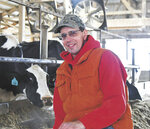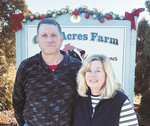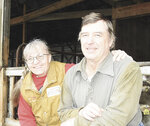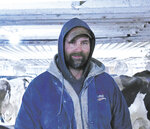



What is your somatic cell count?
Aldinger: Our cell count averaged 82,000 for 2O23.
Huth: Our last seven-day average was 52,000.
Kimm: Our December 2023 bulk tank average was 40,000.
Knisley: My somatic cell is running around 60,000.
What does your milking procedure consist of?
Aldinger: Milking gloves are worn by those who milk. Sand is brushed off the teats. If a cow is dirtier than normal, teats are sprayed with dip and cleaned with paper towels before anything else is done. Milk is then stripped from each teat to check for mastitis or any abnormal milk. Each teat is sprayed with a 1% iodine dip. The next two cows are prepped in this same manner. Then, the first cow is wiped clean and dry with an individual paper towel followed by the next two cows. Milking units are attached to the cows in the same order. They are post dipped with the same dip when milking is completed.
Huth: We start with removing debris from the udder with a gloved hand. Next, we predip with a hydrogen peroxide dip. After one minute, we wipe with paper towel until teats are clean. Milkers are attached 60-90 seconds after wiping. After units come off with automatic takeoffs, teats are dipped with an iodine-based postdip.
Kimm: We first forestrip, then we predip with a hydrogen peroxide/lactic acid based dip. Then we wipe with a paper towel prior to attachment. We have DeLaval automatic takeoffs on a rail system. We postdip with an iodine/chlorohexidine post dip.
Knisley: I strip my cows out, about three squirts per teat, and wipe them with a dry paper towel. Then, about a minute or two later, I put the milking unit on.
How often do you check your SCC, and what ways do you monitor it?
Aldinger: The bulk tank somatic cell tests are texted to my phone after each pickup has been sampled. We use monthly Dairy Herd Improvement Association testing to monitor individual cows.
Huth: We use every other day monitoring of the bulk tank SCC from our creamery to see changes. If we notice an increase of more than 20,000, we start checking sub-groups of cows with a California mastitis test. This is used until the monthly Dairy Herd Improvement Association individual SCC testing can be done. Our goal is to have 50,000 or less for herd SCC.
Kimm: We get bulk tank reports via text. We receive monthly Dairy Herd Improvement Association tests. We also use a California mastitis test on any cows showing any abnormal milk, swollen quarters or those that are off feed.
Knisley: I look at my Dairy Herd Improvement Association sheets and check the list of cows that were high on the last test. Sometimes I use a California mastitis test on the cows that tested high on the last test to see if they’re the problem.
If one of your cows comes down with a high SCC, what is your protocol?
Aldinger: lf we see a few flakes of mastitis, we usually use the quarter milker to keep that milk out of the tank. lf she doesn’t improve in a few days or a cow has a more severe case, we normally treat with either Spectramast or Amoxi-Mast. Any cow that has consistently high cell counts are culled from the herd.
Huth: Grade 1 mastitis cows are monitored but not treated. We use a quarter milker to isolate the infected quarter. Once Grade 2 cows are identified, we work with our veterinarian on culturing and treatment decisions. We do herd health checks twice a month, so it is good to have input from our veterinarian on Grade 2 treatment decisions. We send in DNA polymerase chain reaction samples when needed to identify pathogens. Grade 2 cows are identified with pink marking paint and a sign on the pipeline. Grade 2 mastitis cows in our herd have responded to Spectramast treatment (two doses for three days). We only use on-label treatment with the guidance of our vet, and milk is withheld for at least 72 hours. The cow must also test negative for antibiotics. When Grade 2 cows do not respond to one round of treatment, a decision is made whether we need to cull. If it is a chronically infected cow, she is culled. If a cow responds, we monitor her milk quality with DHIA test. Treatments are recorded in the Farmers Assuring Responsible Managment treatment record by Richard Huth. It is also communicated verbally to all employees who milk. Grade 3 cows are most urgent for treatment. We check for high temperature. We will use a CMT, but usually, we find watery, abnormal milk. Critical care is oral fluid drenching by Richard. Our vet prescribes Polyflex on-label treatment. Treatment is recorded by Richard in the record book. When antibiotics are cleared from meat and milk, we often end up culling these cows. If we have more than one of these cases a year, we revisit our mastitis vaccination protocol with our vet.
Kimm: A cow with a high SCC on test day will be closely watched for abnormal milk or other symptoms of mastitis. Our treatment will depend on severity. Usually, the affected quarter will be treated with ToDAY or Spectramast. LA-200 is sometimes used for a cow with a high fever.
Knisley: I sometimes just let it go and it clears up on its own. If that doesn’t work, I’ll use Spectramast to clear it up. If it’s really bad and doesn’t clear up, the cow is culled.
Why is having a low SCC important to you?
Aldinger: Getting a higher premium for our milk is a big benefit for a low cell count. lt also means treating less cows and throwing away less milk. As dairy farmers, we should want healthy cows as one of our goals. Keeping the SCC low is a good start for having a healthy herd.
Huth: It is important because we strive for healthy cows. When they are healthy, they have high-quality milk. We are proud of the milk we are providing to the consumer.
Kimm: It is one of the best indicators we have of product quality and cow health. The quality bonus for milk with a low SCC is a significant part of the profit margin of producing milk. Not getting all of the potential quality premiums leaves money on the table.
Knisley: Low somatic cell keeps cows healthier. Not having cows get mastitis makes my job easier. It’s good bragging rights with my buddies.
What do you credit your low SCC to?
Aldinger: Sand bedding certainly plays a big role. Keeping cows clean, dry and comfortable is important for low cell counts and overall good health. Culling chronic mastitis cows also helps keep the SCC low.
Huth: We credit our milk quality to being consistent, with good milking and hygiene practices on a daily basis. Cow health is important, and healthy teat ends are part of that. We try our best to keep cows clean and comfortable. Good nutrition is also important to maintain a strong immune system.
Kimm: Attention to details. You don’t have to do anything perfect to maintain a low SCC, but you have to do everything good enough. If there is one weak link in the chain, whatever else you do well will not compensate for that one weak link.
Knisley: I use hydrated lime and sawdust for bedding to keep the cows dry, and I do all the milking. I like clean cows; that’s what helps with low somatic cell. I take good care of my cows. I have good one-on-one time with my herd, and I learn a lot about each animal.
Tell us about your farm.
Aldinger: My wife, Teresa, and I have a 150-acre farm that has been in my family for over 100 years. We raise corn and alfalfa. Milking is done in a double-6 herringbone parlor. Our milk is sold to Plainview Milk Products Cooperative and is shipped 30 miles to the Kwik Trip plant in La Crosse, Wisconsin. Adam Stoehr and Sam Koeller provide part-time milking help. Our daughter and son-in-law, Adriana and Josh Herricks, and their son, Lincoln, live on the farm and lend a hand when needed. We also have a daughter, Hannah, who lives in La Crosse, Wisconsin.
Huth: We are a fifth-generation family dairy farm (started in 1876) in Cameron, Wisconsin. Our milking herd consists of 140 registered Holstein cows. We raise our replacement heifers. Our crop acres consist of corn, soybeans, alfalfa and grass hay. We enjoy teaching youth about the dairy industry with farm visits and tours.
Kimm: We have 575 acres of rolling hills. The herd is mostly registered Brown Swiss. Our cows are housed in a tiestall barn with rubber mats, and we use sunflower hulls for bedding. Brian and Barb farm with our youngest son, Daniel. Another son, Benjamin, will be joining the operation this summer. Daniel and Benjamin are the fourth generation on this farm.
Knisley: I rent a 53-cow tiestall barn and milk 59 cows. I raise my heifer calves and replacement heifers and sell my bull calves. I buy all my feed.
Comments
No comments on this item Please log in to comment by clicking here